Related Research Articles

A comic strip is a sequence of cartoons, arranged in interrelated panels to display brief humor or form a narrative, often serialized, with text in balloons and captions. Traditionally, throughout the 20th and into the 21st century, these have been published in newspapers and magazines, with daily horizontal strips printed in black-and-white in newspapers, while Sunday papers offered longer sequences in special color comics sections. With the advent of the internet, online comic strips began to appear as webcomics.
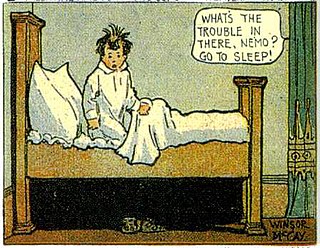
Little Nemo is a fictional character created by American cartoonist Winsor McCay. He originated in an early comic strip by McCay, Dream of the Rarebit Fiend, before receiving his own spin-off series, Little Nemo in Slumberland. The full-page weekly strip depicted Nemo having fantastic dreams that were interrupted by his awakening in the final panel. The strip is considered McCay's masterpiece for its experiments with the form of the comics page, its use of color and perspective, its timing and pacing, the size and shape of its panels, and its architectural and other details.
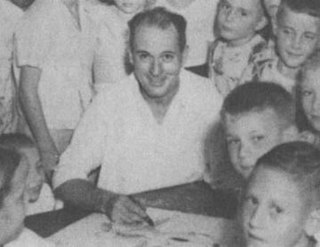
Charles Alfred "Al" Taliaferro, was an American Disney comics artist who produced Disney comic strips for King Features Syndicate. Taliaferro is best known for his work on the Donald Duck comic strip. Many of his strips were written by Bob Karp.

Zenas Winsor McCay was an American cartoonist and animator. He is best known for the comic strip Little Nemo and the animated film Gertie the Dinosaur (1914). For contractual reasons, he worked under the pen name Silas on the comic strip Dream of the Rarebit Fiend.

Little Orphan Annie was a daily American comic strip created by Harold Gray and syndicated by the Tribune Media Services. The strip took its name from the 1885 poem "Little Orphant Annie" by James Whitcomb Riley, and it made its debut on August 5, 1924, in the New York Daily News.

Guy Berkeley "Berke" Breathed is an American cartoonist, children's book author, director, and screenwriter, known for his comic strips Bloom County, Outland, and Opus. Bloom County earned Breathed the Pulitzer Prize for Editorial Cartooning in 1987.

Little Plum is a British comedy western comics series about a little Native American, originally created by Leo Baxendale and published in the magazine The Beano.
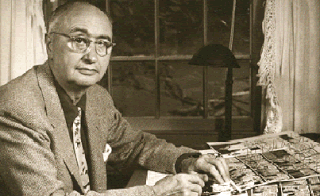
Harold Lincoln Gray was an American cartoonist, best known as the creator of the newspaper comic strip Little Orphan Annie.

A candy thermometer, also known as a sugar thermometer or jam thermometer, is a cooking thermometer used to measure the temperature and therefore the stage of a cooking sugar solution. A candy thermometer is similar to a meat thermometer but can read higher temperatures, usually 400 °F/200 °C or more. Candy thermometers can also be used to measure hot oil for deep frying since it can reach higher temperatures than a normal thermometer.
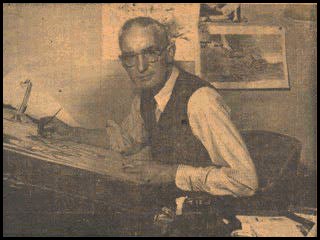
James Llewellyn Frise was a Canadian cartoonist best known for his work on the comic strip Birdseye Center and his illustrations of humorous prose pieces by Greg Clark.
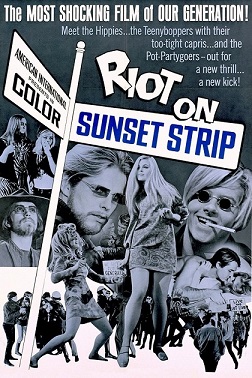
Riot on Sunset Strip is a 1967 counterculture-era exploitation movie, released by American International Pictures. It was filmed and released within four months of the late-1966 Sunset Strip curfew riots.
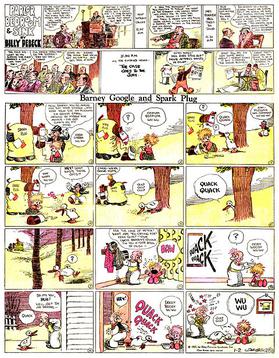
The Sunday comics or Sunday strip is the comic strip section carried in most Western newspapers. Compared to weekday comics, Sunday comics tend to be full pages and are in color. Many newspaper readers called this section the Sunday funnies, the funny papers or simply the funnies.

And Her Name Was Maud is a comic strip by Frederick Burr Opper. It first appeared in the Hearst newspapers on July 24, 1904. After work as a magazine cartoonist, Opper was hired by Hearst in 1899 to draw comic strips for the New York Journal, launching Happy Hooligan, Alphonse and Gaston and And Her Name Was Maud.

The Little King is an American gag-a-day comic strip created by Otto Soglow, which ran from 1930 to 1975. Its stories are told in a style using images and very few words, as in pantomime.

3rd Street in Los Angeles is a major east–west thoroughfare. The west end is in downtown Beverly Hills by Santa Monica Boulevard, and the east is at Alameda Street in downtown Los Angeles, where it shares a one-way couplet with 4th Street. East of Alameda it becomes 4th Street, where it heads to East Los Angeles, where it turns back into 3rd Street upon crossing Indiana Street. 3rd Street eventually becomes Pomona Boulevard in Monterey Park, where it then turns into Potrero Grande Drive and finally turns into Rush Street in Rosemead and ends in El Monte.

Little Iodine is an American Sunday comic strip, created by Jimmy Hatlo, which was syndicated by King Features and ran from August 15, 1943, until August 14, 1983. The strip was a spin-off of They'll Do It Every Time, an earlier Hatlo creation.
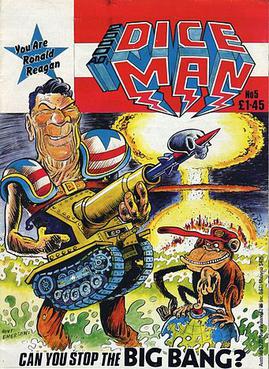
Diceman was a short-lived British comic which ran for five issues in 1986. It was a spin-off from 2000 AD and was devised by Pat Mills, who also wrote almost all of the stories. It was edited by Simon Geller, but purported to be edited by a monster called Mervyn. The stories were designed to be played like gamebooks. Each issue contained two or three such stories and was published every two months.
Norman Lee was a British screenwriter and film director.

Agriculture in the Middle Ages describes the farming practices, crops, technology, and agricultural society and economy of Europe from the fall of the Western Roman Empire in 476 to approximately 1500. The Middle Ages are sometimes called the Medieval Age or Period. The Middle Ages are also divided into the Early, High, and Late Middle Ages. The early modern period followed the Middle Ages.
Donald Duck is an American comic strip by the Walt Disney Company starring Donald Duck, distributed by King Features Syndicate. The first daily Donald Duck strip debuted in American newspapers on February 7, 1938. On December 10, 1939, the strip expanded to a Sunday page as well. Writer Bob Karp and artist Al Taliaferro worked together on the strip for more than 30 years. The strip ended in May 1995.
References
- ↑ Holtz, Allan (2012). American Newspaper Comics: An Encyclopedic Reference Guide. Ann Arbor: The University of Michigan Press. p. 238. ISBN 9780472117567.